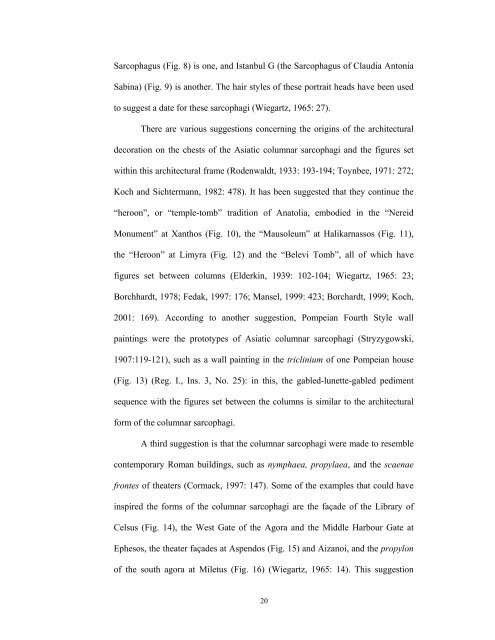To My Family and Uğraş Uzun - Bilkent University
To My Family and Uğraş Uzun - Bilkent University
To My Family and Uğraş Uzun - Bilkent University
Create successful ePaper yourself
Turn your PDF publications into a flip-book with our unique Google optimized e-Paper software.
Sarcophagus (Fig. 8) is one, <strong>and</strong> Istanbul G (the Sarcophagus of Claudia Antonia<br />
Sabina) (Fig. 9) is another. The hair styles of these portrait heads have been used<br />
to suggest a date for these sarcophagi (Wiegartz, 1965: 27).<br />
There are various suggestions concerning the origins of the architectural<br />
decoration on the chests of the Asiatic columnar sarcophagi <strong>and</strong> the figures set<br />
within this architectural frame (Rodenwaldt, 1933: 193-194; <strong>To</strong>ynbee, 1971: 272;<br />
Koch <strong>and</strong> Sichtermann, 1982: 478). It has been suggested that they continue the<br />
“heroon”, or “temple-tomb” tradition of Anatolia, embodied in the “Nereid<br />
Monument” at Xanthos (Fig. 10), the “Mausoleum” at Halikarnassos (Fig. 11),<br />
the “Heroon” at Limyra (Fig. 12) <strong>and</strong> the “Belevi <strong>To</strong>mb”, all of which have<br />
figures set between columns (Elderkin, 1939: 102-104; Wiegartz, 1965: 23;<br />
Borchhardt, 1978; Fedak, 1997: 176; Mansel, 1999: 423; Borchardt, 1999; Koch,<br />
2001: 169). According to another suggestion, Pompeian Fourth Style wall<br />
paintings were the prototypes of Asiatic columnar sarcophagi (Stryzygowski,<br />
1907:119-121), such as a wall painting in the triclinium of one Pompeian house<br />
(Fig. 13) (Reg. I., Ins. 3, No. 25): in this, the gabled-lunette-gabled pediment<br />
sequence with the figures set between the columns is similar to the architectural<br />
form of the columnar sarcophagi.<br />
A third suggestion is that the columnar sarcophagi were made to resemble<br />
contemporary Roman buildings, such as nymphaea, propylaea, <strong>and</strong> the scaenae<br />
frontes of theaters (Cormack, 1997: 147). Some of the examples that could have<br />
inspired the forms of the columnar sarcophagi are the façade of the Library of<br />
Celsus (Fig. 14), the West Gate of the Agora <strong>and</strong> the Middle Harbour Gate at<br />
Ephesos, the theater façades at Aspendos (Fig. 15) <strong>and</strong> Aizanoi, <strong>and</strong> the propylon<br />
of the south agora at Miletus (Fig. 16) (Wiegartz, 1965: 14). This suggestion<br />
20
















